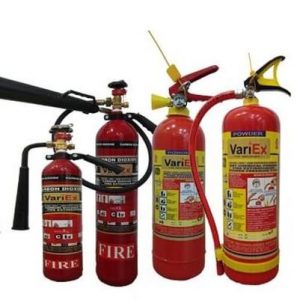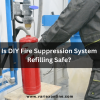![]()
Fire Immuniser
+91-7829629111
Email: info@variex.in
Varistor Technologies Pvt. Ltd.
Block-1, First Floor, Ardente Office One, Hoodi Circle, ITPL Main Road, Bengaluru, Karnataka 560048, IN
Fire Extinguisher Refilling: What Everyone Should Know
Fire safety is a fundamental concern for everyone, and understanding the nuances of fire extinguisher maintenance is essential. In this guide, "Fire Extinguisher Refilling: What Everyone Should Know," we delve into the intricacies of keeping these life-saving devices in optimal condition. Let's explore the basics of fire extinguisher refilling, breaking down the key concepts in layman terms to ensure that everyone can grasp the importance and process of maintaining these critical tools.
Fire extinguishers are our first line of defense against unexpected fires, but merely having them is not enough. Regular maintenance, including refilling, is crucial to ensuring they are ready to tackle emergencies effectively. In "Fire Extinguisher Refilling: What Everyone Should Know," we demystify the common questions surrounding this process, empowering individuals with the knowledge they need to play an active role in fire safety. Whether you're at home, in the office, or any public space, understanding the basics of fire extinguisher refilling is a shared responsibility for the safety of all.
Why Fire Extinguishers Need to be Recharged
Fire extinguishers are crucial tools for safeguarding against potential fire hazards, but it's not enough to simply have them on hand. Understanding why fire extinguishers need to be recharged is vital in ensuring these devices remain effective when it matters most.
What Does Recharging Mean?
In layman terms, recharging a fire extinguisher involves refilling it with the extinguishing agent it uses, such as water, foam, dry chemical, or CO2. Over time, the pressure in the extinguisher can drop, and the chemicals may settle or lose their potency, making a recharge necessary.
Why Fire Extinguishers Need to be Recharged:
- Maintaining Pressure: Just like a soda loses its fizz over time, the pressure in a fire extinguisher can decrease. Recharging ensures that the extinguisher is pressurized, ready to expel its contents forcefully to tackle a fire.
- Preserving Chemical Potency: The chemicals inside fire extinguishers have a shelf life. Recharging involves replacing or topping up these chemicals, ensuring they remain potent and effective in suppressing fires.
- Preventing Settling of Powders: In extinguishers that use dry chemical powders, these substances can settle at the bottom over time. Recharging involves shaking or agitating the extinguisher to prevent clumping and ensure an even distribution of the extinguishing agent.
- Compliance with Safety Standards: Regular recharging is often mandated by safety standards and regulations. It ensures that fire extinguishers meet the necessary criteria for optimal performance during emergencies, aligning with established safety protocols.
- Extending Lifespan: Recharging extends the lifespan of a fire extinguisher. It's a proactive measure to keep the device in prime condition, providing reliable protection over an extended period.
How Often Should Fire Extinguishers be Recharged?
The frequency of recharging depends on the type of extinguisher, its usage, and the manufacturer's recommendations. Regular inspections, usually conducted annually, help determine if a recharge is necessary.
When do Fire Extinguishers Need to be Recharged?
Fire extinguishers are essential tools in keeping us safe from unexpected fires, but just having them is not enough. They require regular attention to ensure they're ready to perform when needed. So, when do fire extinguishers need to be recharged? Let's break it down in simple terms.
1. Annual Inspections: Imagine your fire extinguisher as a superhero waiting in the wings. Annual inspections are like checking its cape and mask to make sure it's still up for the job. During these checks, professionals ensure the extinguisher is pressurized, the chemicals inside are still potent, and there's no wear and tear that might affect its performance.
2. After Use: If your superhero (fire extinguisher) leaps into action and discharges its contents to put out a fire, it needs a recharge. Think of it like refueling a car after a road trip – your extinguisher needs to be topped up to be ready for the next emergency.
3. Pressure Drops: Fire extinguishers work because they release their contents at high pressure to fight fires effectively. Over time, this pressure can drop, just like a balloon losing air. Recharging involves pumping up the pressure, so your extinguisher can still pack a punch when needed.
4. Visual Inspections: You don't need to be a superhero expert to notice when something looks off. If you see any visible signs of damage, leakage, or if the pressure gauge is not in the green zone, it's time for a recharge. Trust your instincts – if it doesn't look right, it probably needs attention.
5. Manufacturer's Recommendations: Picture your fire extinguisher as having its own manual, like a guidebook for superheroes. Manufacturers provide guidelines on how often your extinguisher should be recharged. It's like following the superhero's training schedule to keep them in top shape.
How to Check a Fire Extinguisher Gauge
Checking your fire extinguisher gauge is like giving it a health check to make sure it's always ready for action. Here's how you can do it in simple terms:
Begin by finding the gauge on the top of the extinguisher – it looks like a round dial with a needle. This needle is your extinguisher's way of communicating its status.
Now, focus on the needle's position. Picture the gauge having three zones – green, yellow, and red. Green means your extinguisher is in superhero mode and ready for action. Yellow is a caution sign – it might still work, but it's a sign to get it checked. Red is the danger zone – your extinguisher needs immediate attention.
Consider the gauge as having numbers, like a clock. If the needle is pointing to 12, it's noon – your extinguisher is good to go. If it's closer to 6, it's time to think about a recharge.
Remember, your extinguisher needs an annual check-up, much like your yearly health check. Professionals ensure the gauge is accurate, and your extinguisher is still in superhero shape.
If you notice the needle isn't in the green zone, don't panic. It might just need a recharge – think of it as filling up your superhero's power supply.
However, if you're unsure about the gauge or notice anything unusual, it's time to call in the professionals. They're like the superhero hotline – the experts who can ensure your extinguisher is always ready to save the day.
Understanding the Fire Extinguisher Recharging Process: A Simple Guide
Imagine your fire extinguisher as a hero, ready to leap into action whenever there's a fire threat. But even heroes need a recharge to stay in top form. Here's a straightforward guide to understanding the fire extinguisher recharging process:
When we talk about recharging, it's like giving your hero a boost. After all, a fire extinguisher works by releasing its contents at high pressure to put out a fire. Over time, this pressure can drop, and the chemicals inside may lose their potency.
So, the recharging process involves refilling the extinguisher with its extinguishing agent – whether it's water, foam, dry chemical, or CO2. It's like refueling a car after a long drive to ensure it's ready for the next journey.
When is a recharge necessary? Well, think of it like this: after your hero has fought a fire, it needs a recharge. It's given its all, and now it's time to replenish its powers.
Professionals play a crucial role in the recharging process. They're like the hero's support team. During the recharge, they check the pressure levels, replace or top up the chemicals, and make sure everything is in prime condition.
Recharging extends the lifespan of your fire extinguisher. It's like giving your hero a longer shelf life, so it's always there when you need it.
Picture the recharging process as a routine health check for your hero. It ensures that when the alarm rings and there's a fire threat, your extinguisher is not only present but fully prepared to tackle the challenge.
Stay Protected and Prepared with Fire Extinguisher Recharging Services
Imagine your fire extinguisher as your trusty shield, standing guard against the unexpected enemy – fire. But even the mightiest shields need maintenance to stay strong. That's where fire extinguisher recharging services come in, ensuring your shield is always ready to protect you.
So, what's this recharging all about? It's like giving your shield a power boost. You see, a fire extinguisher works by releasing its contents at high pressure to douse a fire. Over time, this pressure can drop, and the chemicals inside may lose their strength. Recharging is the process of refilling your shield, making sure it's ready for action.
When does your shield need a recharge? Think of it like this: after your shield has bravely faced a fire, it needs a refresh. It's given its all, and now it's time to replenish its powers.
Now, who takes care of this important task? Well, that's where the experts come in – they're like your shield's caretakers. During the recharge, they check the pressure levels, replace or top up the chemicals, and make sure everything is in tip-top shape.
Why bother with this process? It's about extending the life of your shield. Just like a hero needs a reliable shield, you want your fire extinguisher to be there for the long haul, always ready to defend you.
Consider the recharging service as a regular check-up for your shield. It ensures that when the alarm rings and there's a fire threat, your extinguisher is not just there but fully prepared to be your first line of defense.
In wrapping up our journey into the world of fire safety, we've explored the essential topic of "Fire Extinguisher Refilling: What Everyone Should Know." It's like learning the secrets of keeping your superhero, the fire extinguisher, always ready for action.
Remember, "Fire Extinguisher Refilling: What Everyone Should Know" is not just a phrase but a guide to understanding how these life-saving devices work. It's like knowing the superhero's training routine – the annual check-ups, the recharge after a heroic act, and the importance of keeping an eye on that gauge.
So, as we conclude, let's engrain the idea that "Fire Extinguisher Refilling: What Everyone Should Know" is about empowerment. It's about giving everyone the knowledge to be an active part of fire safety. Keep your extinguisher in superhero shape, and you'll always be prepared to face any fire threat that comes your way. Because when it comes to fire safety, knowing what to do is your superpower. "Fire Extinguisher Refilling: What Everyone Should Know" is your guide to being the hero in your own story of safety. Stay informed, stay safe!
Frequently Asked Questions
1.What is fire extinguisher refilling, and why is it important?
Fire extinguisher refilling is the process of replenishing the extinguishing agent inside the device, ensuring it remains effective in combating fires. It's crucial to maintain the extinguisher's readiness, as a depleted or ineffective device may compromise your safety during a fire emergency.
2. How often does a fire extinguisher need to be refilled?
The frequency of fire extinguisher refilling depends on factors such as the type of extinguisher, its usage, and manufacturer recommendations. Annual inspections are typically conducted to determine if a recharge is necessary.
3. Can I refill my fire extinguisher myself?
It is not recommended to refill a fire extinguisher personally. Refilling involves precise procedures, and professional technicians have the expertise to ensure correct pressure, chemical composition, and compliance with safety standards.
4. What signs indicate that a fire extinguisher needs refilling?
Visible signs of damage, leakage, a needle in the red zone on the pressure gauge, or after the extinguisher has been used are indications that it may need refilling. Regular visual inspections are essential for identifying potential issues.
5. Is fire extinguisher refilling a legal requirement?
While it may not be a legal requirement in all jurisdictions, regular maintenance, including refilling, is often mandated by safety standards and regulations. Adhering to these standards ensures the device's optimal functionality during emergencies.
Final Say
We at VariEx.in or Variexonline.com have mastered the art of designing, installing, inspecting, and fixing automatic sprinkler systems with the help of our in-house team, which is capable of delivering the fire sprinkler services you need, whether large or small and at affordable cost.
To schedule a fire sprinkler installation, or you think our services could benefit your commercial property, contact us online or give us a call at, 7829629111










